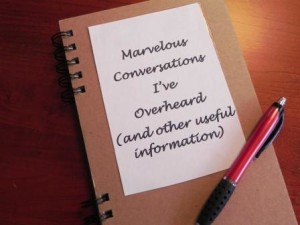Three of the most frequently asked questions I get from people about my writing are:
- Do you write in the morning/afternoon/at night?
- What do you use to write? (Computer/word processor/paper&pen)
- Where do you get your ideas?
It’s this last question that I’d like to tackle.
Recently, I attended my mother-in-law’s family reunion. The small group gathered where they have every year for 75 years — Garden City, Iowa. The intoxicating aroma of fresh-baked pies, fried chicken, and shredded beef permeated the small community center. Attendees ranged in age from their late 80s to 7 years old. In short order, all of the children disappeared outside to play on the playground. Later, they had to be coaxed inside to eat. Sometime during the afternoon, a train rumbled past. An old, upright piano tucked in a corner begged to be played. No one indulged. Clusters of family members sat together reminiscing. Others received introductions to those they either didn’t know, or couldn’t remember. And, I found myself thinking, “There’s a story here.”
That’s where ideas come from. It’s the day-to-day, seemingly simple events that spark an idea. All it takes is one simple question, “What if?”
Since I write mysteries, my process always begins the same way. I see or hear something, and then I ask that question. I keep asking that question until I’ve written a complete first draft. I can write a first draft in less than thirty days. It’s the revisions and editing that take much longer. And, during that phase, my question changes from a steady stream of “what if?” to “why?”
My focus is exploring what makes people commit a crime. It doesn’t have to be murder. But, it always involves one or more of the seven deadly sins. Every crime boils down to this. Sometimes, it’s obvious which deadly sin is at play. Other times, it’s not. People are, as Shrek once said, like onions. They have layers. So, as I write and revise an idea, those layers peel away. In Deadly Sins Complete, not every suspect is layered. Why? Because some people really are that simple, and that’s what makes the situation more complex. We have a difficult time getting our heads around how, or why, someone could behave a particular way, and this leads us to complicate what we’re either witnessing, or involved in. That’s where there still are layers.
If you find yourself struggling for ideas, do this:
- Try observing the people around you. Spend a few hours, in different locations, just watching and listening to people. Write one sentence describing whatever you’re seeing or hearing.
- Pay closer attention to the emotions you see people expressing. Figure out why you’re seeing what you’re seeing. Write two sentences describing the emotions you’re seeing.
- Pay closer attention to your behavior. What makes you happy, sad, angry, frustrated, or disgusted?
- What are your triggers for those emotions?
- How do you look when you express those emotions?
- How do other people look when they do?
When I’m asked, “Where do you get your ideas?” The honest answer is, “everywhere.” The bigger question is, “How do you create a compelling story from what you see or hear?” No one has asked me that, yet, but the answer is, finding a common denominator. In my case, it’s the deadly sins. In yours, it might be the virtues. When I figured out what I wanted to write about (the deadly sins) story ideas flowed more easily. This doesn’t mean it’s always easy. Originally, Deadly Sins Complete had 10 stories. I scrapped one because it wasn’t flowing. That story got ripped apart and refocused to become “Yellow Bones.”
At the end of the day, it comes down to becoming an astute people watcher and eavesdropping.

